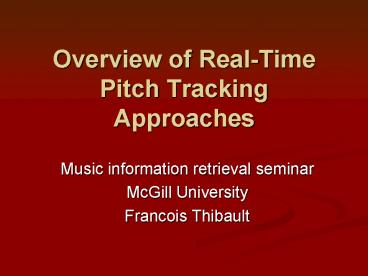Overview of Real-Time Pitch Tracking Approaches - PowerPoint PPT Presentation
Title:
Overview of Real-Time Pitch Tracking Approaches
Description:
Least-Squares fitting (Choi 97) Maximum Likelihood (McAulay 86, Puckette 98) Other approaches... Least-Squares fitting approach ... – PowerPoint PPT presentation
Number of Views:58
Avg rating:3.0/5.0
Title: Overview of Real-Time Pitch Tracking Approaches
1
Overview of Real-Time Pitch Tracking Approaches
- Music information retrieval seminar
- McGill University
- Francois Thibault
2
Presentation Goals
- Describe the requirements of RT pitch tracking
algorithm for musical applications - Briefly introduce key developments in RT pitch
tracking algorithms - Provide insight on what techniques might be more
suitable for a given application
3
Pitch tracking requirements in musical context
- Must often function in real-time
- Minimal output latency
- Accuracy in the presence of noise
- Frequency resolution
- Flexibility and adaptability to various musical
requirements - Pitch range
- Dynamic range
4
Overview of techniques
- Time-domain methods
- Autocorrelation Function (Rabiner 77)
- Average Magnitude Difference Function (AMDF)
- Fundamental Period Measurement (Kuhn 90)
- Frequency-domain methods
- Cepstrum (Noll 66)
- Harmonic Product Spectrum (Schroeder 68)
- Constant-Q transform (Brown 92)
- Least-Squares fitting (Choi 97)
- Maximum Likelihood (McAulay 86, Puckette 98)
- Other approaches
5
Autocorrelation method
- Based on the fact that periodic signal will
correlate strongly with itself offset by the
fundamental period - Measures to which extent a signal correlates with
a time-shifted version of itself - The time shifts which display peaks in the ACF
corresponds to likely period estimate
6
Autocorrelation Pros/Cons
- Simple implementation (good for hardware)
- Can handle poor quality signals (phase
insensitive) - Often requires preprocessing (spectral
flattening) - Poor resolution for high frequencies
- Analysis parameters hard to tune
- Uncertainty between peaks generated by formants
and periodicity of sound can lead to wrong
estimation
7
AMDF
- Again based on the idea that a periodic signal
will be similar to itself when shifted by
fundamental period - Similar in concept to ACF, but looks at
difference with time shifted version of itself - The time shifts which display valleys correspond
to likely period estimates
8
AMDF Pros/Cons
- Poor frequency resolution
- Even simpler implementation then ACF (good for
hardware) - Less computationally expensive then ACF
- Combination of AMDF and ACF yields result more
robust to noise (Kobayashi 95)
9
Fundamental Period Measurement approach
- Signal is first ran through bank of half-octave
bandpass filters - If filters are sharp enough, the output of one
filter should display the input waveform freed
of its upper partials (nearly sinusoidal) - It is up to a decision algorithm to decide which
filter output corresponds to fundamental
frequency - Time between zero crossings of that filter output
determines period
10
FPM Pros/Cons
- Easy implementation (hardware and software)
- Efficiency of computation
- Decision algorithm highly dependent on thresholds
- But, automatic threshold setting provided for
most situations
11
Cepstrum approach
- Tool often used in speech processing
- Cepstrum is defined as power spectrum of
logarithm of the power spectrum - Clearly separate contribution of vocal tract and
excitation - A strong peak is displayed in the excitation part
(high cepstral region) at the fundamental
frequency - Use a peak picker on cepstrum and translate
quefrency into fundamental frequency
12
Cepstrum Pros/Cons
- Less confusion between candidates than in ACF
- Proven method, especially suitable for signal
easily characterized by source-filter models
(e.g. voice) - Relatively computationally intensive (2 FFTs)
13
Harmonic Product Spectrum approach
- Measures the maximum coincidence of harmonics for
each spectral frame - Resulting periodic correlation array is searched
for maximum which should correspond to
fundamental frequency - Algorithm ran for octave correction
14
HPS Pros/Cons
- Simple to implement
- Does well under wide variety of conditions
- Poor low frequency resolution
- Computing complexity augmented by zero padding
required for interpolation of low frequencies - Requires post-processing for error correction
15
Constant-Q transform approach
- First computes the Constant-Q transform to obtain
constant pattern in log frequency domain (Q
fc/bw) - Compute the cross-correlation with a fixed comb
pattern (ideal partial positions for given
fundamental frequency) - Peak-pick the result to obtain fundamental
frequency
16
Constant-Q Pros/Cons
- Complexity of constant-Q reduced but still
(Brown and Puckette 91) - Sensitive to octave errors
- Other peaks could be candidates
17
Least-Squares fitting approach
- Perform least-squares spectral analysis --gt
minimize error by fitting sinusoids to the signal
segment - Strong sinusoidal components are identified as
sharp valleys in least-square error signal - Relatively few evaluation of the error signal are
required to identify a valley - Fundamental frequency is obtained as average of
partial frequencies over their partial number - Uses rectangular windowing to provide faster
response
18
LS fitting Pros/Cons
- Operates on shorter frame segments
- Best option for real-time applications with
minimum latency requirements - Efficient evaluation scheme allows reasonable
computation complexity
19
Maximum Likelihood
- Maximum likelihood algorithm searches trough a
set of possible ideal spectra and chooses closest
match (Noll 69) - Was adapted to sinusoidal modeling theory, by
finding best fit for harmonic partials sets to
the measured model (McAulay 86) - Enhance discrimination by suppressing partials of
small amplitude values
20
ML Pros/Cons
- Inherits high computational requirement from
sinusoidal modeling - Very robust estimation
- Allows guess of fundamental frequency even with
several partials missing.
21
Other approaches
- Neural Nets (Barnar 91)
- Hidden Markov Models (Doval 91)
- Parrallel processing approaches (Rabiner 69)
- Fourier of Fourier transforms (Marchand 2001)
- Two-way mismatch model (Cano 98)
- Subharmonic to harmonic ratio (Sun 2000)
22
Conclusions
- Lot of research still Motivated by speech
telecommunication - Abundant literature since 1950
- Complete and objective performance overviews
seems missing - Combination of techniques in parallel processing
seems foreseeable with todays fast computers































